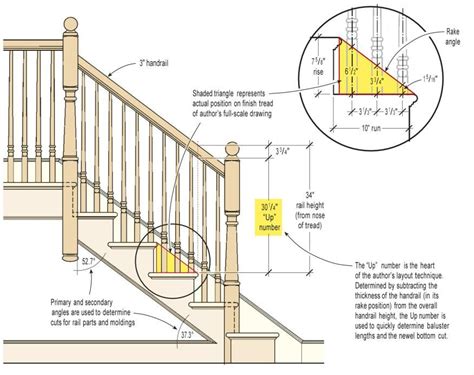How To Measure Stair Railing
Ronan Farrow
Apr 01, 2025 · 3 min read

Table of Contents
How to Measure Stair Railing: A Comprehensive Guide
Measuring for a stair railing might seem daunting, but with the right approach and tools, it becomes a straightforward process. Accurate measurements are crucial to ensure a perfect fit and safe installation. This guide provides a step-by-step process to help you confidently measure your stairs for a new railing.
Essential Tools for Accurate Measurements
Before you begin, gather these essential tools:
- Measuring Tape: A long, flexible measuring tape (at least 25 feet) is crucial for accurate measurements. A tape measure with a locking mechanism will be particularly helpful.
- Level: A level will ensure you take measurements on a perfectly horizontal or vertical plane, crucial for accurate railing placement.
- Pencil and Notepad: Jot down measurements as you go to avoid errors and ensure you have a complete record.
- Calculator: Useful for calculating total lengths and angles.
- Camera: Taking photos of your staircase from various angles can be incredibly helpful, especially when dealing with complex stair designs.
Step-by-Step Measurement Guide
The process of measuring a stair railing involves several key steps:
1. Determining the Railing's Total Length
This is the most crucial measurement. The total length will dictate the amount of railing material you need.
- Start at the Top: Begin at the top landing and measure the horizontal distance to the bottom landing.
- Measure Each Tread: Measure the horizontal length of each stair tread. Add these lengths together.
- Account for Rises: Measure the vertical rise of each stair. This is less critical for the overall railing length but crucial for determining the angle and the overall design.
- Calculate the Total: Add the total horizontal distances from steps and the horizontal distance between landings to determine the overall railing length. Remember to add extra length for any curves or bends in the staircase.
2. Measuring the Height and Angle
The height and angle of your staircase play a critical role in railing design and safety.
- Measure the Overall Rise: Determine the total vertical distance from the bottom landing to the top landing.
- Measure Individual Rises: Measure the vertical height from the top of one tread to the top of the next. Consistency in rise height is important for safety.
- Assess the Angle: Observe the angle of the staircase. A steep staircase will require a more robust railing design.
3. Addressing Curves and Bends
If your staircase features curves or bends, measuring becomes slightly more complex.
- Divide and Conquer: Break down the curved sections into smaller, manageable segments.
- Use String: Use a string to follow the curve of the railing. After you've measured the string, lay it out flat to determine its length.
- Consider the Radius: For curved sections, you'll need to determine the radius of the curve to ensure that your railing material can accurately accommodate this bend.
4. Measuring for Newel Posts and Balusters
- Newel Post Placement: Determine the locations for the newel posts (vertical posts at the beginning and end of the railing). Measure the distance between them.
- Baluster Spacing: Decide on the spacing between balusters (vertical supports between newel posts). Building codes often dictate minimum spacing requirements for safety. Measure the distance between balusters and their placement along the handrail.
5. Documenting Your Measurements
Once you've completed all measurements, meticulously record them in your notepad, including sketches or photos of the staircase and specific measurements for each section. This will be invaluable when ordering materials or working with a professional installer.
Tips for Success
- Double-check your measurements: Accuracy is paramount. Double-check all measurements to minimize errors.
- Consider building codes: Consult your local building codes for regulations regarding stair railing design and safety requirements.
- Seek professional help if needed: If you're unsure about any aspect of the measurement process, don't hesitate to consult a professional carpenter or contractor.
By following these steps, you'll be well-equipped to accurately measure your stair railing, ensuring a safe and aesthetically pleasing installation. Remember to prioritize safety and precision throughout the entire process.
Featured Posts
Also read the following articles
| Article Title | Date |
|---|---|
| How To Make Dirt Bike Faster | Apr 01, 2025 |
| How To Hang Stained Glass Window | Apr 01, 2025 |
| How To Keep A Knocked Out Tooth Moist | Apr 01, 2025 |
| How To Level A Field | Apr 01, 2025 |
| How To Keep Livestock Guardian Dogs From Roaming | Apr 01, 2025 |
Latest Posts
-
Essence Pore Minimizing Serum How To Use
Apr 03, 2025
-
Epsom Salt Bath For Goldfish How Often
Apr 03, 2025
-
Energizer Power Bank How To Charge
Apr 03, 2025
-
Emsculpt Neo How Many Sessions
Apr 03, 2025
-
Elizavecca How To Use
Apr 03, 2025
Thank you for visiting our website which covers about How To Measure Stair Railing . We hope the information provided has been useful to you. Feel free to contact us if you have any questions or need further assistance. See you next time and don't miss to bookmark.
